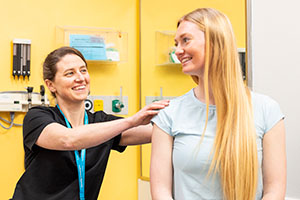Developmental Dysplasia of the Hip (DDH)
What is developmental dysplasia of the hip?
Developmental dysplasia of the hip (DDH) is the name for a wide range of problems with the way a child’s hips form. Some of these problems are present at birth (). Others may develop as your child grows.
Hip dysplasia can range from mild to serious. In some children, DDH means only that their hip sockets are shallow. In other children, it means their leg bones are out of the hip (dislocated).
We can successfully treat most infants and children who have DDH. For the best results, it is important to start treatment early. Early treatment with a harness or brace helps avoid the need for surgery. Children who do not get help can develop a limp and early-onset as adults. There are both surgical and nonsurgical treatment options for older children, teens and young adults with hip problems related to dysplasia.
About 1 in every 10 children in the United States has some form of DDH. About 1 in 1,000 has a dislocated hip. Most children with DDH are girls. An infant who was bottom first in the womb (breech baby) is more likely to have hip dysplasia. So are children with family members who have the condition.
Child and Young Adult Hip Preservation at Seattle Children
What are the symptoms of DDH?
Most of the time, you will not see any symptoms of DDH in your baby. But some that can show up include:
Legs held in positions that don’t match
You might see this most easily when your child lies on their back with their knees bent. One of their legs may fall easily away from the middle of their body and the other may not go as far (asymmetric abduction). One leg stops sooner because the upper thighbone (femur) runs into the pelvis. If the thighbone is dislocated, you might feel a clunk as it drops into the socket (acetabulum) with movement.
One leg appears shorter than the other
In most children with DDH, their legs are actually the same length. But 1 leg may look shorter if the thighbones are in different positions. If your child is walking, the difference might make your child limp. Most of the time, young children with DDH do not have pain in their hip, so pain is not usually the cause of limping. Teens and young adults with DDH sometimes develop hip pain over time.
Uneven hip fat or thigh folds
When you look at your child from the back, you might see different creases or folds in the skin and fat around 1 hip or thigh compared to the other. For example, there might be a difference in the creases where their legs meet their bottom (buttocks). Or there might be more folds on the inner thigh of 1 leg than on the other. This can happen if the thighbones are not in the same position. However, it might not mean your child has DDH or any other condition.
How is DDH diagnosed?
When your baby is born, the doctor will check both hips to make sure they are stable. The doctor will do a hip exam, gently moving your baby’s legs to look for signs that the bones move into and out of the sockets.
Babies change as they grow, so doctors will do a hip dysplasia exam for your child many times as they get older, often at regular well-baby exams.
If we think your baby might have hip dysplasia and they are younger than 4 months, we may ask for an of the hips. If your child is older than 4 months, we may take .
Breech babies are at higher risk for hip dysplasia. So, even if your baby’s hips seem fine in an exam, the doctor may recommend doing an ultrasound or x-ray to be sure.
Seattle Children’s have special expertise using ultrasound and other to look for bone and joint changes in children with DDH. Having high-quality images helps your child’s team diagnose and treat their problem and prevent future issues.
How is DDH treated?
To treat DDH successfully, it is important to find the condition early. The most helpful type of treatment depends on how old your child is when DDH is found.
- In the first few months of life, babies often can wear a harness to fix the problem.
- Babies older than 6 months may need a cast or brace. Often, they need surgery.
- Those who are older than 1 year usually need surgery.
All types of treatment have the same goal: putting the hip joint back in place and keeping it there. This kind of treatment is called reduction. It not only helps with your child’s hip early in life. It also lowers their risk of problems later on, like getting arthritis or needing a hip replacement as a young adult.
There are several methods of reduction, including a Pavlik harness, a fixed hip abduction brace, surgery (open reduction) and a spica cast.
-
Treatment from 0 to 6 months of age
The youngest babies may wear a Pavlik harness (PDF) (Spanish). This is a soft harness that flexes. It pulls the baby’s legs away from their middle while still letting them move their legs some. The harness keeps the ball (femoral head) at the top of the thighbone deep in the socket.
This is the simplest form of reduction treatment. It works about 80% to 85% of the time.
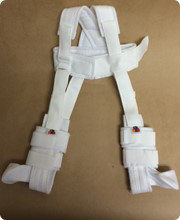
Doctors may use a Pavlik harness to treat hip dysplasia in young babies. The straps at the top go over the baby’s shoulders. The wider strap below the shoulders goes around the baby’s chest. The lower straps hold the baby’s legs so their hips stay in the right position. If a Pavlik harness does not work for your child after a month or so, we may try a more rigid brace (fixed hip abduction brace like the Rhino Cruiser or Ilfeld brace). This type of brace may work better to hold your baby’s hips in a safe position and direct the femoral head into the socket.
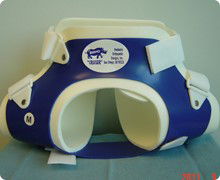
This is a Rhino Cruiser brace. The upper part of the brace goes around the baby’s middle. The lower part holds their legs out to each side so their hips stay in the right position. At Seattle Children’s Orthopedics and Sports Medicine, we have a system to help make sure babies referred to us for severe dysplasia or a dislocated hip get care soon. This improves the chance that a harness or brace will work and they won’t need surgery.
-
Treatment from 6 to 18 months of age
If the Pavlik harness does not work or if your child is older than 6 months, they may need a spica cast (PDF) (Russian) (Spanish) (Vietnamese) or a special brace to hold the thighbone in the hip socket.
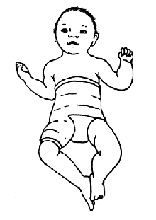
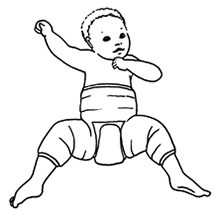
A spica cast goes around the baby’s middle. Then it goes around 1 or both legs. It may stop above the knee or between the knee and ankle. The cast holds 1 or both hips in a fixed position. First, the doctor will need to put the thighbone in the socket. Your child will have general anesthesia so they sleep and cannot feel anything anywhere in their body. Then the doctor will move the thighbone into place. If possible, they will do this without surgery (closed reduction).
If the thighbone will not go in easily, the doctor will operate to put it in (open reduction). They will open the hip, release any soft tissues that are blocking the thighbone and then put the ball into the socket.
In some children, the hip tendon on the inside of the thigh (adductor tendon) is tight, so doctors need to release it. We do this by making a small cut through the skin and tendon.
After the hip is in place, the doctor will put on the cast or brace.
-
Treatment from 18 months to about age 5
After about age 18 months, children usually need surgery to redirect or reshape the bones of the hip, the pelvis or the thighbone so their hips will stay aligned.
After surgery, your child will wear a spica cast (PDF) (Russian) (Spanish) (Vietnamese) on their hips and legs. The length of time in the cast depends on the child. For most children, it is 6 to 12 weeks. In some cases, the doctor may recommend changing the cast. This can allow for your child’s growth and let the doctor check the position of the hip again.
After the doctor removes the cast, your child will wear a brace to hold their hips in place, usually for about 3 to 6 months. They will wear the brace until X-rays show that their hip socket is developing in a healthy way.
This approach is common up to about age 5, when children typically start school and wearing a spica cast is not practical.
-
Treatment from ages 5 to 10
If a child needs treatment for hip dysplasia from about age 5 to 10, this usually means surgery to treat shallow hip sockets. Physical therapy is an important part of recovery after hip surgery. At Seattle Children’s, we have physical therapists who specialize in hip conditions in kids.
-
Hip preservation or replacement after age 10
Most of the time, we can treat hip dysplasia early in life with 1 of the methods described above. After treatment, most children have no further issues with their hips.
Sometimes, children, teens or young adults with hip dysplasia do have ongoing hip issues. Or they develop a new concern, like hip pain, as their body gets larger and their joints have to carry more weight. Some people with hip dysplasia are not diagnosed until symptoms, like a limp or pain, begin in adolescence.
The Child and Young Adult Hip Preservation Program provides treatment to help older children and teens keep their natural hip and delay or avoid hip replacement. We also work with young adults in their 20s who are seeking care. From some, nonsurgical treatment like physical therapy may help. If it doesn’t, they may need a hip preservation surgery, like . For those who do need an artificial hip, we offer this option as well. Learn more about the Child and Young Adult Hip Preservation Program.
Why choose Seattle Children’s for treatment of DDH?
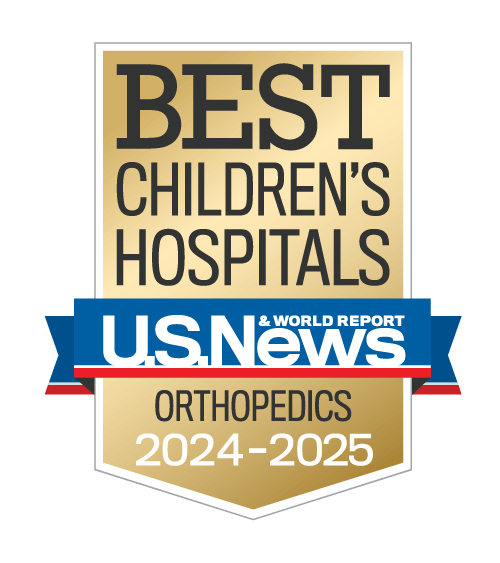 Seattle Children’s Orthopedics and Sports Medicine team provides complete care for babies, children, teens and young adults with DDH. We are known nationally for our skill in treating hip dysplasia.
Seattle Children’s Orthopedics and Sports Medicine team provides complete care for babies, children, teens and young adults with DDH. We are known nationally for our skill in treating hip dysplasia.
Teens and young adults need different care for dysplasia than younger children do. Within Orthopedics, our Child and Young Adult Hip Preservation Program offers specialized care for these patients to restore function in their natural hip and delay or avoid hip replacement.
-
The hip experts you need are here
- Your child’s team includes doctors, surgeons, and from Orthopedics and Sports Medicine. We also involve specialists in , , and based on your child’s needs
- Accurate diagnosis is the first step to effective treatment. Our team is experienced in making high-quality imaging studies using , , advanced , and .
- Our first goal is to treat your child without surgery if we can. Often, this means a harness, brace, cast or physical therapy. We have onsite orthotists to build and fit orthotics to correct hip problems. We also have the largest team of physical and occupational therapists in the region who specialize in babies, children, teens and young adults.
- We recommend surgery only when we believe it will give your child the best results. If your child needs surgery, our surgeons have many years of experience in treating children with hip dysplasia. Each of our hip surgeons is . Many have expanded fellowship training, including to treat hip conditions in young people even into their 20s.
- Dr. Todd Blumberg leads the Child and Young Adult Hip Preservation Program. He focuses on treating hip conditions from infancy into adulthood. Blumberg is the only dual fellowship-trained pediatric and hip preservation surgeon in the region. Seattle Children’s does more hip preservation surgeries for young people than any other center in the Pacific Northwest.
- Complex hip conditions may affect other parts of your child’s body too. That’s why we connect you with the many types of Seattle Children’s experts your child may need — on the same day, in the same clinic, whenever we can.
-
Our approach to surgery aims to get you the best results
- Before we recommend surgery, we look at your child as a whole person. Your child’s team will take many factors into account. These include how serious their condition is, the effects on their health, how much more they will grow and what results you can expect from treatment.
- We have the technology and skills to use imaging to guide hip surgery, if needed. This helps us place hardware, like screws, with precision. It also lets us see in real time the changes we make to the hip. Our operating rooms have the newest, low-dose imaging equipment available.
- Our surgeons are experienced in procedures to move the thighbone into the hip socket and to reshape the bones of the hip, pelvis or thigh, if needed. Our focus is on keeping your child’s natural hip if possible. However, we also place artificial hips at Seattle Children’s. Dr. Jesse Roberts is experienced in hip replacement surgery for young people.
-
Hip care from birth through young adulthood
- We specialize in caring for young patients, from babies through young adults. Our experts have the knowledge, training and skills to diagnose and treat hip dysplasia and related issues that your child might have at any age.
- Babies, children and teens are still developing. When we evaluate your child’s condition, plan their treatment and provide their care, we carefully consider their growth. We think about how growth may affect their hip over time. We also consider how their hip may affect the rest of their development and health. Here, your child’s team has special training in the physical, emotional and social needs of young people.
- Even into their 20s, young people may benefit from different hip treatments than older adults do. So, it’s important to have a team, like ours, that understands hip development and the needs of this age group. After hip surgery here, people in their 20s can keep seeing our Child and Young Adult Hip Preservation team for long-term follow-up. To care for young adult patients, we also partner with orthopedic surgeons at UW Medicine.
- If your child needs imaging that uses radiation, we use the lowest amount possible (PDF) to make the best image. We have a low-dose radiation X-ray machine, called the EOS. It makes safer full-body images. We also have the largest group of pediatric radiologists in the Northwest.
-
Support for your whole family
- Having a child with hip dysplasia can be stressful for the whole family. From the first visit to follow-up, our team will work to give your child seamless care and make your experience here as easy on you as we can.
- Your child’s team does more than plan and provide care for your child. We also make sure you and your child understand your child’s condition and treatment options. We support you in making choices that are right for your family.
- For your convenience, our doctors see patients at locations in Seattle, Bellevue, Everett and Federal Way. We bring high-quality care closer to where you live.
- Seattle Children’s serves families from around the Northwest and beyond. We can help with financial counseling, education, housing, transportation, interpreter services, spiritual care and more. Our Child Life specialists, Family Resource Center and Guest Services are here to help. Read more about our services for patients and families.
-
Research and advances to improve hip care
- Our team members partner with experts around the world on research. Together, they work to understand the causes of hip conditions, improve the accuracy of diagnostic tests and create better surgical approaches.
- We track long-term results of our patients so we can improve care for young people with hip problems. For example, we ask patients with hip dysplasia about their experience before and after treatment to make sure our approach improves quality of life and function.
- Our surgeons have led research to reduce your child’s exposure to radiation from imaging tests, like and , before and during surgery.
- As part of our constant work to improve results for kids, we developed standard plans (called protocols) to help your child recover after surgery.
- Learn more about current orthopedics research at Seattle Children’s.
Contact Us
Contact Orthopedics and Sports Medicine at 206-987-2109 for an appointment, a second opinion or more information.
Providers, see how to refer a patient or read the infant hip dysplasia algorithm (PDF).
Paying for Care
Learn about paying for care at Seattle Children’s, including insurance coverage, billing and financial assistance.


